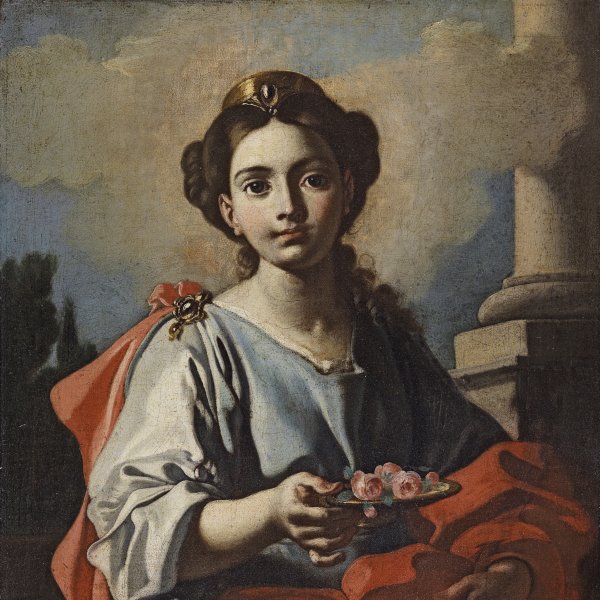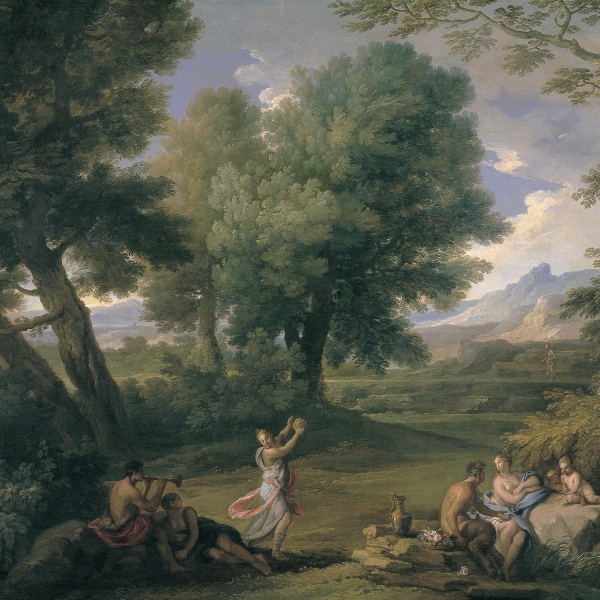The Sacrifice of Polyxena
Oil on canvas.
72 x 58 cm
Museo Nacional Thyssen-Bornemisza, Madrid
Inv. no.
324
(1977.18
)
Not exhibited
Level 2
Permanent Collection
Level 1
Permanent Collection
Level 0
Carmen Thyssen Collection and Temporary exhibition rooms
Level -1
Temporary exhibition rooms, Conference room and EducaThyssen Studio
Polyxena, with whom Achilles fell in love, was the younger daughter of Priam and Hecuba, the king and queen of Troy. She was partly responsible for Achilles’ death, having promised him her hand if he raised the siege on the city, a false promise and a trap that would bring about his death. Following Polyxena’s wishes, Achilles came to make a sacrifice to Apollo, at which point Polyxena’s brother Paris shot an arrow into Achilles’ heel, his only vulnerable point, inflicting a fatal wound on the hero. After Achilles’ death his spirit presented itself to his son Neoptolomus and exhorted him to sacrifice Polyxena in the place where his tomb had been erected and as part of the spoils of war. The episode is related by Ovid in the Metamorphoses (Book XIII) in which the angry Achilles berates the Greeks for not having made a sacrifice to him on his death, for which reason he demands the sacrifice of Polyxena. The young woman was “snatched from the arms of her mother and led to Achilles’ tomb” where “preferring death to slavery she urged Neoptolomus to swiftly plunge the knife into her throat”.
Pittoni was particularly interested in this subject and repeated it on a number of occasions in the 1730s. In addition to his own interest in this classical subject we should assume that it appealed to the clients who purchased his paintings. Pittoni first painted this subject in a vertical composition of large size previously in the palazzo Caldogno Tecchio in Vicenza (lost in World War II), which can be dated to around 1720 on the basis of photographs. Its composition already includes elements that appear in later versions of the theme. Franca Zava Boccazzi made a detailed study of Pittoni’s compositions of this subject and divided them into three types. The prototype of the first, of which the present work is an example, is the painting in the Staatsgalerie, Stuttgart, which is vertical and of small format. The model for the second type is the painting in the J. Paul Getty Museum, Los Angeles, which is also vertical but much larger. The third type is large in scale and horizontal and is based on the work in the palazzo Taverna in Rome.When constructing these compositions Pittoni looked to his own series of Tombs with regard to the architectural elements and the sitters, as well as his panting of Christ and the Woman taken in Adultery (Graves Art Gallery, Sheffield) for the figure of Polyxena.
The present canvas is painted using a pleasing range of colours with an emphasis on blue tones in the draperies, architectural elements and accessories. The scene is constructed with a limited number of figures, among them Neoptolomus, wearing a red cloak and pointing to the altar. Polyxena has a melancholy, resigned expression as she accepts her fate, while an old man points to the tomb of Achilles at the upper right. Of the three types of composition identified by Zava Boccazzi, this is the simplest with regard to the setting. Despite its high quality the present work has been considered a studio work by specialist authors.
Mar Borobia
Pittoni was particularly interested in this subject and repeated it on a number of occasions in the 1730s. In addition to his own interest in this classical subject we should assume that it appealed to the clients who purchased his paintings. Pittoni first painted this subject in a vertical composition of large size previously in the palazzo Caldogno Tecchio in Vicenza (lost in World War II), which can be dated to around 1720 on the basis of photographs. Its composition already includes elements that appear in later versions of the theme. Franca Zava Boccazzi made a detailed study of Pittoni’s compositions of this subject and divided them into three types. The prototype of the first, of which the present work is an example, is the painting in the Staatsgalerie, Stuttgart, which is vertical and of small format. The model for the second type is the painting in the J. Paul Getty Museum, Los Angeles, which is also vertical but much larger. The third type is large in scale and horizontal and is based on the work in the palazzo Taverna in Rome.When constructing these compositions Pittoni looked to his own series of Tombs with regard to the architectural elements and the sitters, as well as his panting of Christ and the Woman taken in Adultery (Graves Art Gallery, Sheffield) for the figure of Polyxena.
The present canvas is painted using a pleasing range of colours with an emphasis on blue tones in the draperies, architectural elements and accessories. The scene is constructed with a limited number of figures, among them Neoptolomus, wearing a red cloak and pointing to the altar. Polyxena has a melancholy, resigned expression as she accepts her fate, while an old man points to the tomb of Achilles at the upper right. Of the three types of composition identified by Zava Boccazzi, this is the simplest with regard to the setting. Despite its high quality the present work has been considered a studio work by specialist authors.
Mar Borobia









